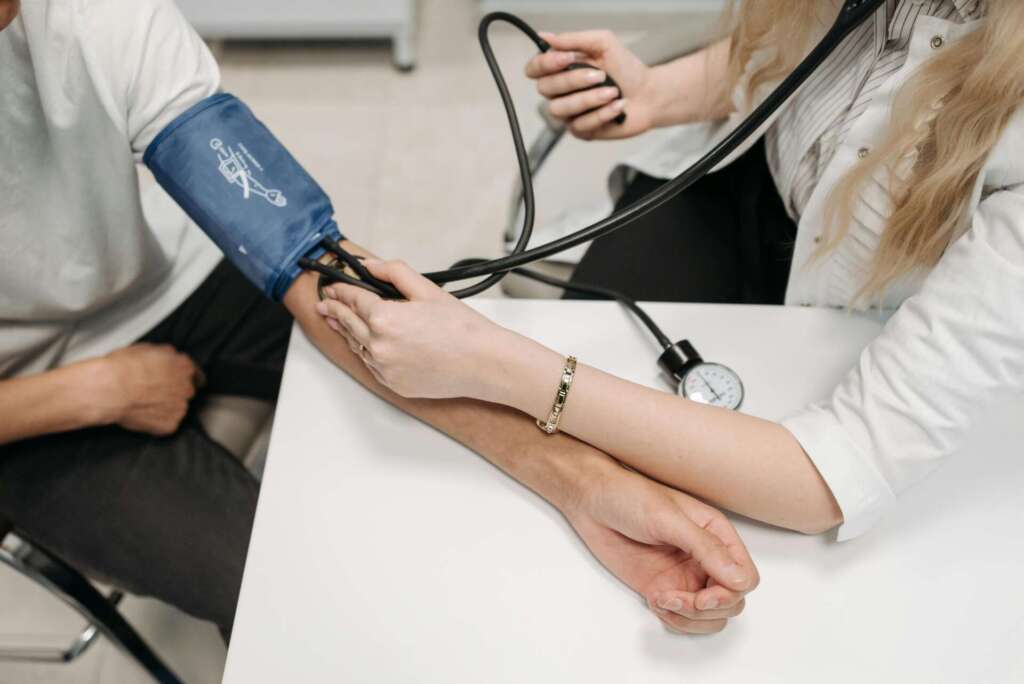In today’s world, many of us spend a lot of time sitting. Whether it’s at a desk job, watching TV, or scrolling through our phones, we’re often not moving much. This kind of lifestyle, where we sit a lot and don’t get enough physical activity, is called a sedentary lifestyle and it comes with many health risks.
What Is a Sedentary Lifestyle?
A sedentary lifestyle means you’re not getting enough physical activity throughout the day. Think of it like a car that’s parked and not driven very often. Just like a car needs to run regularly to stay in good condition, our bodies need movement to stay healthy.
Sedentary lifestyles primarily involve you being seated. Anything from watching television, playing video games, scrolling through social media on your phone, working at your computer, sitting at school or while commuting are considered sedentary activities.
Why is a sedentary lifestyle bad for us?
When we sit too much, our bodies go into “sleep mode.” Here are some ways a sedentary lifestyle can affect our health:
- Weight Gain: If we’re not moving, our bodies don’t burn as many calories. It’s like putting fuel in the car but never driving it – eventually the tank overflows. For us, that means extra weight.
- Heart Health: Our heart is like a pump that needs regular exercise to stay strong. When we don’t move enough, our heart doesn’t get the workout it needs which can lead to high blood pressure and cardiovascular disease.
- Muscle and Joint Problems: Imagine if you never moved your arms – they’d get stiff and weak. The same happens with our whole body when we sit too much. Our muscles and joints can get stiff and weak and lead to pain and discomfort.
- Mental Health: Physical activity helps our brains release chemicals that make us feel good. Without enough movement we might feel more anxious or depressed.
Sedentary lifestyle in terms of energy expenditure
Energy expenditure is a way to measure how much energy we use during different activities. One common measure is the Metabolic Equivalent of Task (MET). Sitting quietly, like watching TV or reading, is considered to be 1 MET – i.e. low energy. expenditure.
A 1.5 MET activity uses 1.5 times the energy you would use at rest. This is like doing very light activities, such as slow walking or light housework. While 1.5 MET activities are better than just sitting, they still don’t use much energy.
To stay healthy, we need to aim for more vigorous activities that use higher METs, like brisk walking or jogging. By understanding METs, we can better plan our daily activities to ensure we’re moving enough to keep our bodies healthy.
How To Get Out of a Sedentary Lifestyle

Physical activity is the answer. Ages, races, ethnicities, shapes, sizes, and abilities notwithstanding, everyone can benefit from physical activity.
Getting out of a sedentary lifestyle doesn’t have to be daunting. Start with small changes that build up your activity over time. Find an exercise you enjoy – dancing, swimming or join a local sports team and make it a regular part of your routine. Even small activities like gardening or playing with pets can make a big difference. Remember it’s all about consistency and making movement a part of your daily habit. By doing this you’ll not only improve your physical health but also your mood and energy levels.
What are the benefits of physical activity?
- It helps fight and prevent unhealthy weight gain.
- Regular physical activity reduces the risk of many chronic diseases, such as heart disease, some cancers, and type 2 diabetes.
- It greatly reduces feelings of anxiety and improves sleep quality.
- Enhanced cognitive ability with reduced risk of dementia.
- It improves your overall bone and musculoskeletal health.
Follow these guidelines to live a dynamic life:
- Aim to do something active every day.
- Invest 150 minutes daily for moderate intensity physical activity weekly OR
- Invest 75 minutes of high intensity physical activity weekly.
- Divide your activity sessions into smaller 10-minute chunks to make them more manageable.
- Allocate time for building muscle strength with suitable exercises or activities twice weekly.
How to stay active throughout the day

Ann’s Top Tips
As a doctor, I recommend that people get creative with their methods to combat the risks of a sedentary lifestyle. Improvising ways to stretch your body naturally – even if to add a brisk 3 minutes of activity here or there can help improve and sustain your health.
Here are a few examples of creative ways you can sneak in some physical activity into your everyday activities:
- park further away from the store
- take the stairs instead of the elevator
- take a short stroll during Zoom meetings
- spend some time working at a standing desk
- walk more briskly when shopping
- spend time walking your pets, or getting some active play in with your kids
A few minutes here and there during routine activities throughout the day can add to real benefits in heart health and longevity.
Medical Conditions Influenced By Your Activity Levels
The Sedentary Behavior Research Network (SBRN) is a global organisation that aims to improve our understanding of sedentary lifestyles and their effects on our health. SBRN brings together researchers, health professionals and policymakers to share knowledge, collaborate on research and raise awareness of the risks of a sedentary life.
If you’re ever looking for trusted information on the patterns, causes and health outcomes of sedentary behaviour (like sitting for long periods), or searching for effective strategies and interventions to reduce sedentary time to live and active life, the Sedentary Behavior Research Network is a great resource to refer to.
In the meantime though, here’s some of the main medical conditions you have an increased risk of getting if you have sedentary behaviors.
Sedentary lifestyle and cancer
Physical activity is a powerful natural way to reduce the risk of many cancers. Exercise helps you maintain a healthy weight, reduces inflammation and boosts your immune system all of which are key to preventing cancer. For example physical activity can reduce the risk of breast and colon cancers by regulating hormones and speeding up digestion so the harmful substances don’t stay in your digestive tract for long. Exercise can also reduce the risk of endometrial and lung cancers by improving overall health and reducing exposure to cancer causing agents. By doing physical activity regularly you can cut your cancer risk and overall well being.
Sedentary lifestyle and cardiovascular disease

Regular physical activity is one of the most effective ways to lower the risk of cardiovascular disease. Exercise strengthens the heart muscle, improves blood circulation, and helps manage weight, all of which contribute to a healthier heart. It also helps regulate blood pressure and cholesterol levels, reducing the risk of hypertension and atherosclerosis (narrowing of the arteries). Physical activity enhances the body’s ability to use insulin, which helps prevent type 2 diabetes, a major risk factor for heart disease. By making exercise a consistent part of your daily routine, you can significantly reduce your risk of cardiovascular disease mortality and enjoy a healthier, more energetic life.
Sedentary lifestyle and type 2 diabetes
A sedentary lifestyle can lead to increased risk of type 2 diabetes. When you exercise your muscles use more glucose (sugar) from the blood stream, which keeps your blood sugar levels in check. Physical activity also makes your body more sensitive to insulin the hormone that regulates blood sugar. So your body can use insulin more efficiently and reduce the risk of insulin resistance a major factor in type 2 diabetes. Exercise also helps with weight management and weight is key to preventing diabetes. By incorporating physical activity into your daily routine you can reduce your risk of type 2 diabetes and overall metabolic health.
Tom’s Sedentary Lifestyle: Health Risks
Tom, 28, is a software developer who spends most of his waking hours sitting due to his job. His day is filled with long periods of sitting (up to 12 hours a day!), minimal exercise and evenings spent watching TV or browsing the internet. Tom felt like he was due for a regular health check up, so he decided to book an appointment with me.
I took a thorough history and physical exam. Tom had no major medical conditions but admitted to feeling more tired than usual and having back pain. I was concerned that Tom’s inactivity and prolonged periods of sitting would pose big risks for his health.

Findings and Diagnosis
Upon further examination, I found several minor health issues related to Tom’s sedentary lifestyle, including:
- Excess Body Weight: Tom is slightly above the healthy weight for his height.
- High Blood Pressure: Tom’s blood pressure is in the higher end of normal.
- Lower Back Pain: Possibly caused by poor posture and long periods of sitting.
I warned Tom that these are early warnings for more serious health problems like cardiovascular disease, mental health issues, type 2 diabetes and even premature death if not addressed soon. Citing the World Health Organization’s guidelines, I let him know that physical inactivity is a major global health risk.
Recommendations and Treatment Plan
I created a plan to help Tom become more active and healthy:
- Physical Activities:
- Daily Exercise: Tom should be physically active – with 30 minutes of moderate physical activity to vigorous physical activity most days of the week. Examples are brisk walking, cycling or swimming.
- Light Intensity Movements: Do light intensity activities like standing or stretching every hour to break up long periods of sitting.
- Behavioral Nutrition:
- Balanced Diet: Tom should eat a balanced diet rich in fruits, vegetables, lean proteins and whole grains and reduce processed foods and sugary drinks.
- Hydration: Drink plenty of water throughout the day to stay hydrated and avoid snacking unhealthy foods.
- Workplace Adjustments:
- Ergonomic Changes: Adjust his workspace to promote better posture like using an ergonomic chair and a standing desk.
- Regular Breaks: Take short breaks every hour to stand, walk or stretch and reduce sitting time.
- Mental Health:
- Stress Management: Do activities that promote mental health like mindfulness meditation, yoga or hobbies that reduce stress.
- Social Activities: Engage in social or group activities that involve physical movement to improve physical and mental health.
Follow-Up and Outcome
Tom agreed to try his best to make these lifestyle changes over the next few months. He started to increase his physical activities, jogging in the morning and walking in the evening. He also adjusted his work habits by taking regular breaks and improving his sitting posture.
At our follow-up visit, Tom looks much healthier. His weight is within the healthy range, his blood pressure is down and his back pain is less. Tom tells me that he feels more energetic and mentally well and credits it to his new active lifestyle and better nutrition.
Key Takeaway
Tom’s case shows the risks of sedentary lifestyle and the importance of addressing physical inactivity early to prevent serious health problems. By being active, behavioral nutrition and workplace adjustments, Tom reduces his risk factors and improves his overall health and mental well-being. This case proves the need for proactive health management to live life to the fullest and long.
Conclusion
Living a sedentary lifestyle can have serious effects on our health, but making small changes can lead to big improvements. Think of your body like a car – it runs best when it’s used regularly. So, get up, move around, and keep your body in top shape!
For more practical health tips, watch my video down below:
References
- Center for Disease Control (CDC). Physical Activity. Available here.
- National Health Services (NHS). Why Sitting Too Much is Bad For Us. Available here.
- Park, J., et al. (2020). Sedentary Lifestyle: Overview of Updated Evidence of Potential Health Risks. Available here.
Disclaimer: The contents of this article and the video attached are for educational purposes only, and not intended to be a substitute for professional medical advice, diagnosis, or treatment. Always get advice from your doctor if you are worried or have symptoms.


